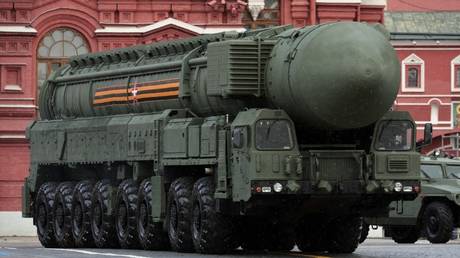ARTICLE AD BOX
ONLY five per cent of Nato states’ air defences are ready to protect Europe’s eastern flank in the event of WW3, according to the alliance.
But it is determined still to send a message to Russia, and reassure its members, that it is strong enough to stave off an invasion.
 Getty
Getty EPA
EPA Getty
Getty EPA
EPA
Nato has begun rolling out the big guns in Lithuania during what is its biggest military exercise since the Cold War, Steadfast Defender.
Leopard 2 tanks fired rounds as helicopter blades buzzed ahead and Puma fighting vehicles rolled up for the crescendo of the drills.
Germany‘s defence chief General Carsten Breuer said: “Today’s exercise sends a clear message – a message of deterrence to Russia.”
Some 90,000 troops from 32 Nato states have taken part in land, sea, and air Steadfast Defender drills over the past six months.
But the message the war games on the eastern flank – Nato’s frontline if the war in Ukraine bubbles over – intends to send Russia could be at odds with Nato’s capabilities, according to a Financial Times report.
People familiar with top-secret defence plans drawn up last year said Nato states can provide less than five per cent of the air defences necessary to protect Allies against a full-scale attack in central and eastern Europe.
One senior Nato diplomat said the ability to thwart missile and air strikes was “a major part of the plan to defend eastern Europe from invasion,” adding: “And right now, we don’t have that.”
The shock claim comes amid warnings from top European leaders and military officials that Russia might be capable of attacking a Nato member by the end of the decade.
Moscow this week issued a fresh wave of threats after France and Germany joined Western governments in giving Ukraine the green light to use their weapons to strike targets inside Russia.
Ukraine’s international allies have previously insisted that any weapons they provide must be used exclusively within Ukrainian territory.
President Vladimir Putin warned that European governments “should be aware of what they are playing with,” given their smaller land areas and “dense populations”.
He added: “This is a factor that they should keep in mind before talking about striking deep into Russian territory.”
Russia’s war with Ukraine has driven home the need for Nato allies to improve their air defence systems.
Putin’s forces used more than 300 missiles, 300 Shahed-type drones, and 3,200 guided bombs in attacks on Ukraine just last month, said Ukrainian President Volodymyr Zelenskiy.
The UK stated in a defence review last year that the “challenge of protecting … against attack from the skies” was “its most acute for over 30 years”.
A second Nato diplomat told the Financial Times: “[Air defence] is one of the biggest holes we have. We can’t deny it.”
The UK’s air defence capability has been described by experts as “inadequate”, with the Royal Navy‘s six Type 45 destroyers – equipped with ballistic missile defence systems – dogged by design flaws.
West gives Ukraine green light to strike inside Russia
FRANCE and Germany have joined Western governments in giving Ukraine the green light to use their weapons to strike inside Russia.
Ukraine’s international allies have previously insisted that any weapons they provide must be used exclusively within Ukrainian territory.
French president Emmanuel Macron and Germany’s Chancellor Olaf Scholz made their positions clear during Macron’s visit to Germany this week.
Mr Macron said late on Tuesday that Ukraine should be allowed to “neutralise military sites from which the missiles are fired”.
He added: “We must not allow Ukraine to hit other targets in Russia, of course civilian targets, or other military targets.”
The president’s comments followed Ukrainian complaints that Russia is launching attacks from within its borders using assets that Ukraine cannot strike.
A spokesperson for Mr Scholz said on Wednesday that “defensive action is not limited to one’s own territory, but also includes the territory of the aggressor”.
They added that Germany’s terms for use of its weapons were “confidential”.
President Vladimir Putin later warned that European governments “should be aware of what they are playing with,” given their smaller land areas and “dense populations”.
He added: “This is a factor that they should keep in mind before talking about striking deep into Russian territory.”
And although the army has six advanced Sky Sabre ground-based air defence systems, their missile interceptors have a range of just 40km.
A Nato official said “capability targets and defence plans are classified” but air and missile defences “are top priorities”.
The official said: “Nato’s new defence plans also significantly increase air and missile defence requirements in quantity and readiness.
“We are confident that Nato’s deterrence against Russia remains strong.”
Increased investment in fighter jets is understood to form part of allied countries’ air defence spending.
Russian foreign ministry spokeswoman Maria Zakharova said last week that Moscow will retaliate with strikes on British targets in and outside of Ukraine if British weapons are used to strike Russia.
But military and security experts are not convinced Russia will follow through with its threats.
 Getty
Getty Getty
Getty Getty
Getty Getty
Getty.png)
 5 months ago
5
5 months ago
5








 English (US)
English (US)